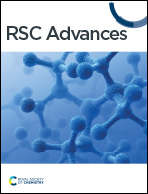Integrated hybrid modeling and SHAP (SHapley Additive exPlanations) to predict and explain the adsorption properties of thermoplastic polyurethane (TPU) porous materials†
Abstract
As a novel type of oil–water separation material, thermoplastic polyurethane (TPU) porous material exhibits many excellent properties such as low density, high specific surface area, and outstanding oil–water separation performance. However, the performance of thermoplastic polyurethane (TPU) porous materials is often impeded by various factors, and conducting numerous experiments to investigate the relationship between these factors and the adsorption performance can be both expensive and time-consuming. As an alternative to these experiments, machine learning (ML) techniques can be used to estimate experimental results. Therefore, in this study, we developed an integrated hybrid model to predict the adsorption performance of materials and replaced some experiments. We also constructed XGBoost (XGB), Decision Tree Regressor (DT), K-Neighbors Regressor (KNN), Bagging Regression (BGR), and Extra Trees Regression (ETR) single models to predict material properties, all of which exhibited high prediction accuracy. On this basis, SHAP values were employed to explain the influence of single-factor and multi-factor characteristics of such materials on material properties.



 Please wait while we load your content...
Please wait while we load your content...